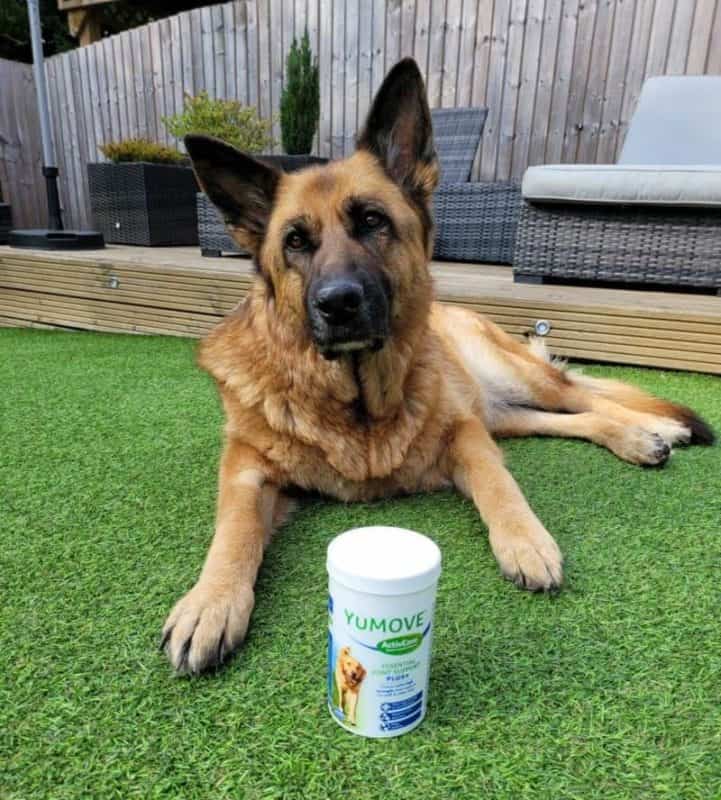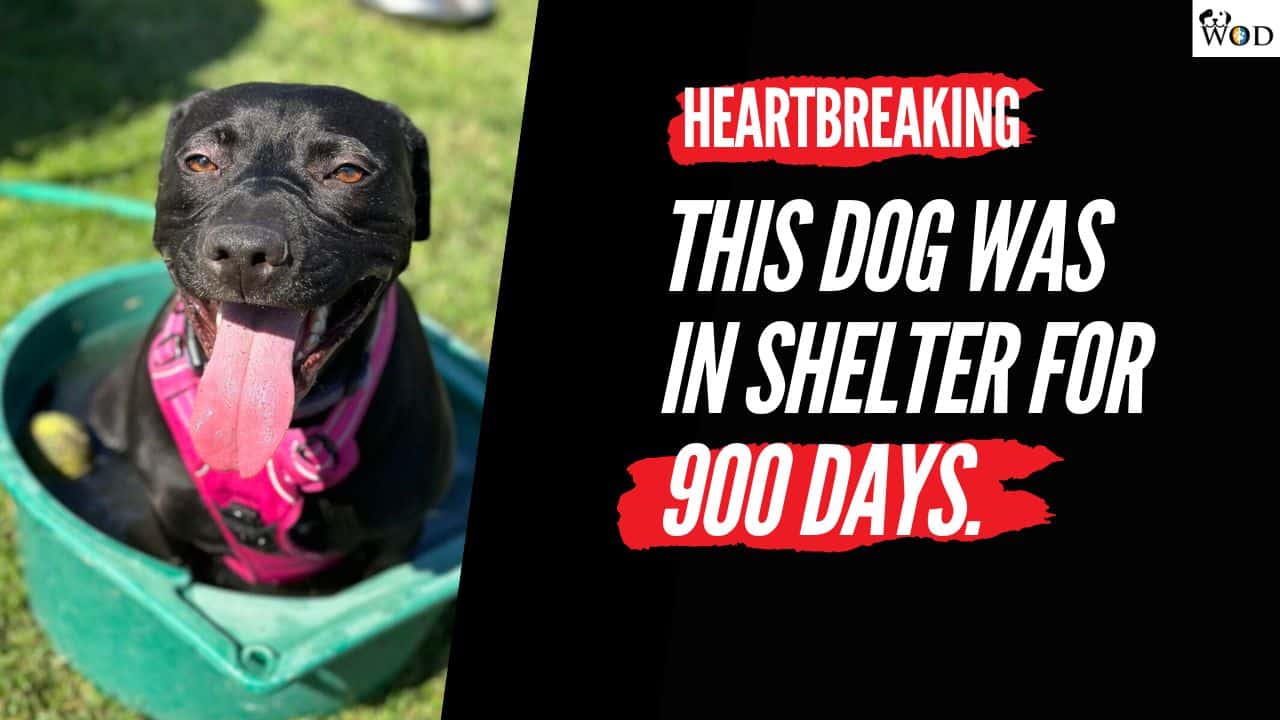As a new German Shepherd owner, my most common question was, “What’s the best diet for German Shepherds?” Feeding your dog the proper nutrition and a well-balanced diet plan is critical to its overall health and well-being. To understand the best dog food for your German Shepherd and how to provide for them, you must know what nutrients they need and in what amounts.
The best diet for German Shepherds is a high-quality, protein-rich diet consisting of 18-22% protein. Dogs can also derive nutrients from grains, fruits, and vegetables. However, all dogs must ensure they have the right balance of protein, fats, vitamins, minerals, and fiber for optimum health.
In this article, you’ll discover everything you need to know about diet & nutrition for German Shepherds, in addition to meal plans.
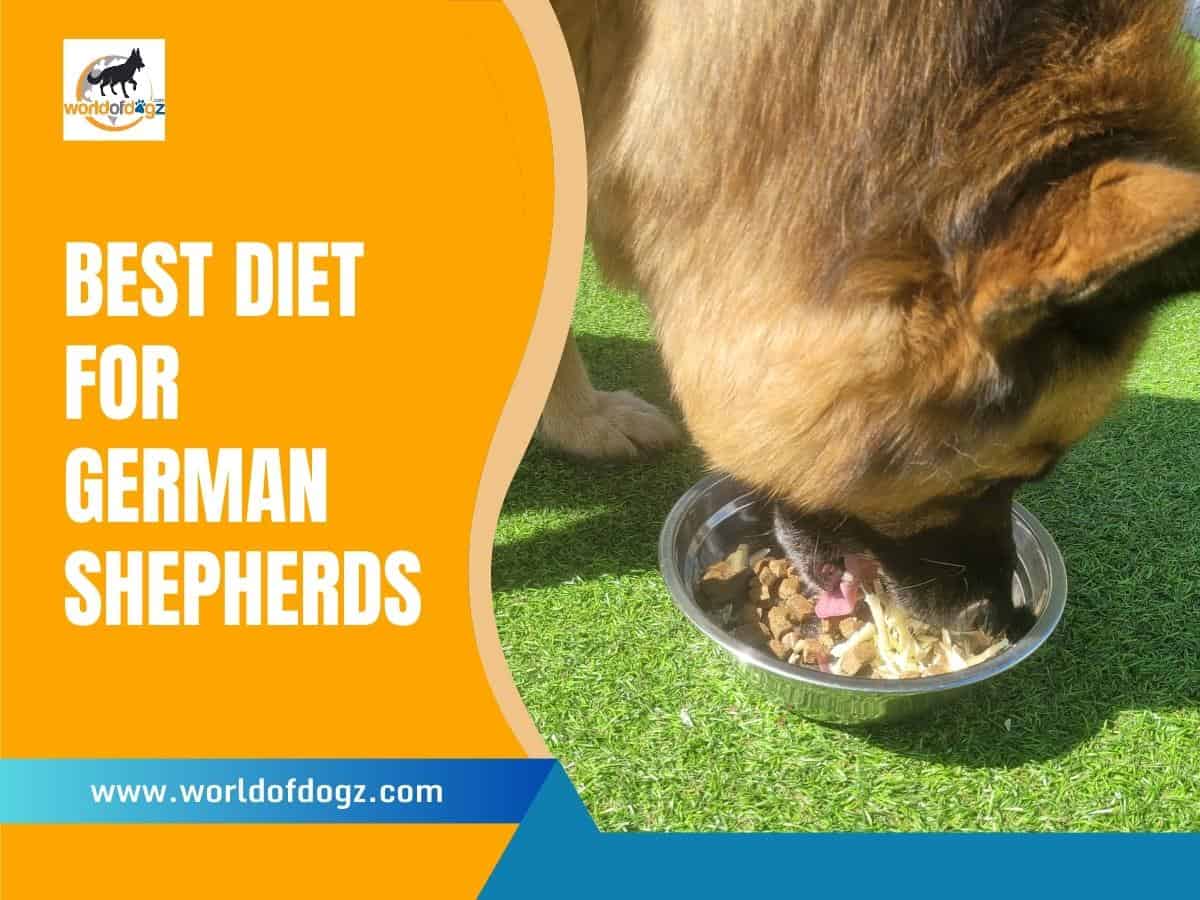
Feeding Geman Shepherds: Key Nutrients
German Shepherds need at least 22% protein during growth stages and 18% protein once an adult. German Shepherd puppies need 8% fat, and adults require 5% fat to meet their energy needs. Carbohydrates, vitamins, minerals, and water are also necessary for survival.
You must include these essential nutrients in a German Shepherd’s daily diet as they are involved in all of the body’s vital functions.
All commercial pet foods’ nutritional content must follow the guidelines developed by the AAFCO (Association of American Feed Control Officials).
The MSD Vet Manual also publishes dog nutrient profiles which contain a ton of detail listing all the individual vitamins and minerals a German Shepherd’s diet needs.
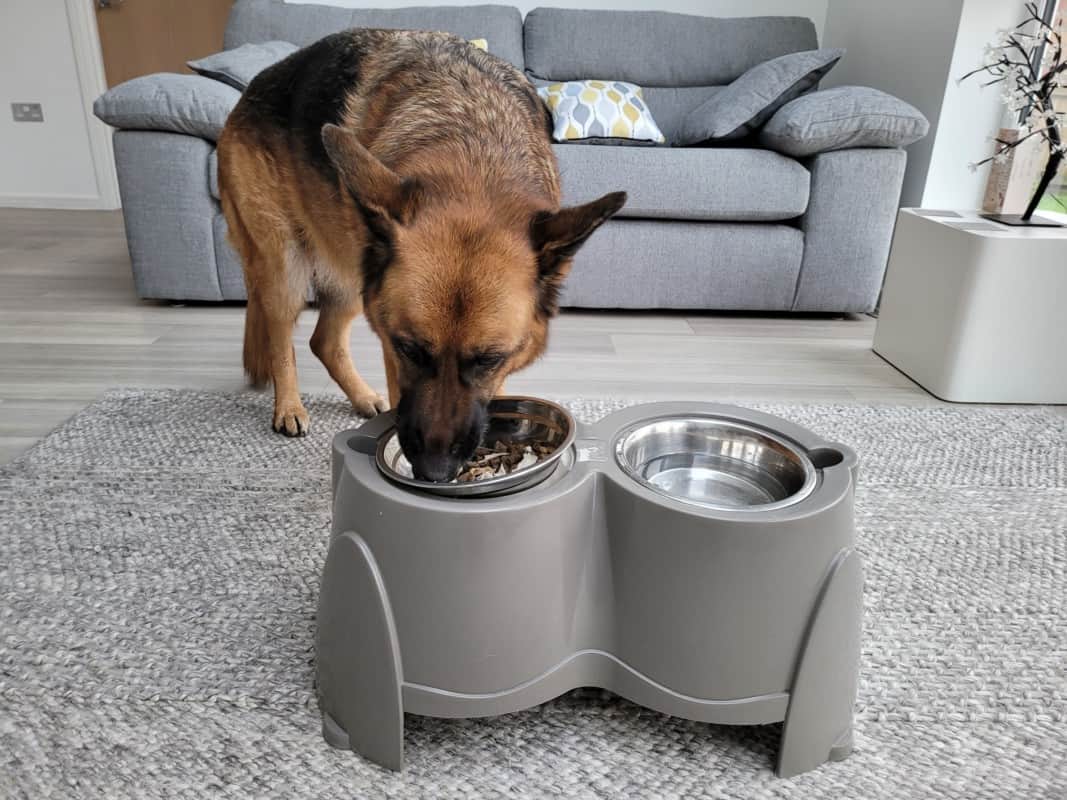
Best Diet For German Shepherds
When considering the best diet for a German Shepherd, choose foods with high-quality animal-based protein sources such as beef, chicken, lamb, pork, eggs, fish, and plant-based proteins, such as grains, legumes, and vegetables. Also, the food should be abundant in fats, vitamins, and minerals.
Protein
The main nutritional requirement of a German Shepherd’s diet is protein. Protein has several functions:
- Provides energy.
- Builds and repairs muscles
- Forms new skin, hair, and nail cells.
- Keeps the immune and musculoskeletal systems strong.
The amount of protein required by puppies and adult German Shepherds is different. Growing puppies require a minimum of 22% protein, whereas adult dogs require a diet of 18% protein.
If feeding commercial dog food, protein is measured on a dry matter basis, meaning what’s left after the moisture is extracted.
Fat
The second main nutritional requirement of a German Shepherd’s diet is fat. Fat comes from protein and provides energy. It is also necessary for the normal development and function of body cells, nerves, muscles, and tissues.
Again, the amount required for puppies and adult German Shepherds differ. The recommended fat content for growing puppies is 8% and 5% for an adult dog.
Your German Shepherd’s diet will also have different nutritional needs depending on life stage, size, activity level, and overall health:
- An active and growing puppy may need twice as many calories as an adult GSD.
- A pregnant or lactating dog will need considerably more calories.
- An elderly German Shepherd may need 20% fewer calories in their diet than middle-aged dogs.
“My active German Shepherd will require a completely different diet than a lap dog that likes to laze around all day.”
Check Out This Video on The Best Diet For German Shepherds…
So, what are the recognized life stages of dogs? The AAFCO defines them as:
- Gestation/lactation (pregnancy and nursing).
- Growth (includes puppies).
- Adult maintenance.
- All life stages.
So that got me wondering, what exactly does “all life stages” mean?
A German Shepherd’s diet for all life stages meets the nutritional requirements for growth, reproduction, and adult maintenance. This diet is, therefore, suitable for GSDs of any age.
One thing to note is that an “all life stage” diet is generally higher in calories, so you would only choose this diet depending on your dog’s circumstances.
For example, if your dog is an adult, inactive, or needs to lose weight, you should choose a diet for adult maintenance. If your dog is working or highly active, you may choose a diet for “all life stages” due to the extra calories and nutrition.
Different quantities, ratios of nutrients, and feeding rates are advised for different life stages when selecting the right pet food.
What Do German Shepherds Eat?
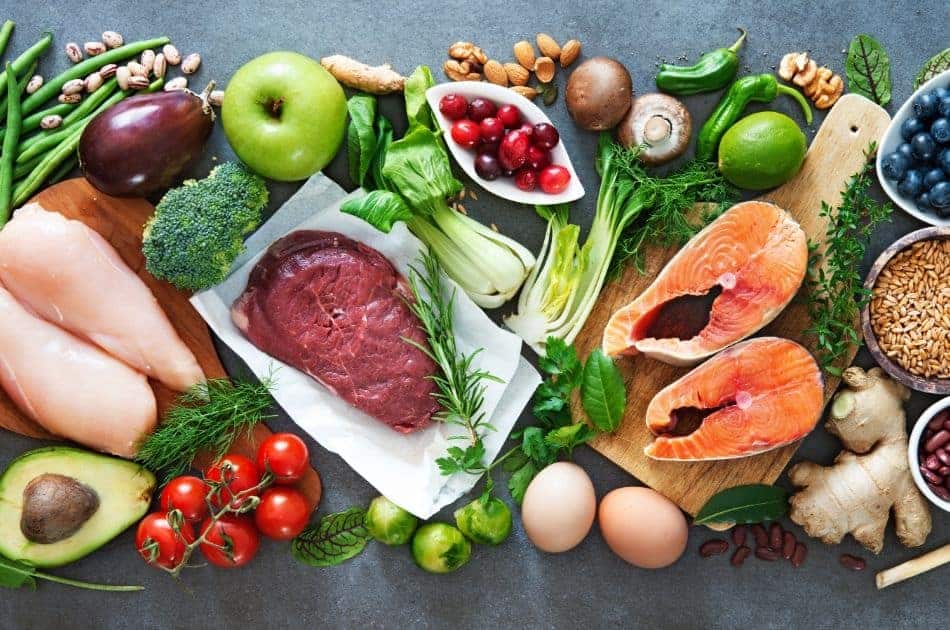
So now we know what nutrients GSDs need, let’s look at what they can eat. These are the main foods of a balanced German Shepherd’s diet. However, they do come with some caveats, so read on!
| PROTEINS | GRAINS |
|---|---|
| Beef | Wheat |
| Pork | Corn |
| Lamb | Oats |
| Venison | Oatmeal |
| Chicken | Rice |
| Turkey | Maize |
| Duck | Barley |
| Liver | Quinoa |
| Kidney | Buckwheat |
| Heart | Rye |
| Fish | Teff |
| Salmon | Amaranth |
| Tuna | Bulgar |
| Mackeral | Spelt |
| Eggs | Millet |
| NUTS | DAIRY |
|---|---|
| Peanuts | Milk |
| Cashews | Cream |
| Almonds | Ice-cream |
| Hazelnuts | Yogurt |
| Chestnuts | Cheese |
| VEGETABLES | FRUITS |
|---|---|
| Artichoke | Apple |
| Asparagus | Apricot |
| Beets | Banana |
| Bell Peppers | Blackberries |
| Broccoli | Blueberries |
| Brussel Sprouts | Coconut |
| Cabbage | Cranberries |
| Carrot | Cucumber |
| Cauliflower | Dates |
| Celery & Corn | Kiwi Fruit |
| Eggplant | Mango |
| Green Beans | Melon |
| Lettuce | Nectarine |
| Parsnips | Peach & Plum |
| Peas | Persimmon |
| Potato (cooked) | Olive |
| Pumpkin | Orange |
| Rutabaga | Pear |
| Spinach | Pineapple |
| Sweet Potato | Raspberries |
| Squash | Strawberries |
| Zucchini | Watermelon |
Here are the caveats to know:
- If a fruit contains pits or seeds, you should remove them as they contain toxic cyanide.
- You should cook most vegetables first to help with digestion.
- You should feed fruits, vegetables, dairy, and nuts in small amounts – no more than 10% of daily calories.
- Although GSDs can eat some nuts, they are not recommended due to their high fat content, which can cause an upset stomach.
- Feeding raw eggs or raw fish is not advisable due to the risk of salmonella or listeria.
- Some GSDs are lactose intolerant and can not eat certain dairy foods, depending on the amount of lactose.
Do you want to know more about what fruits and vegetables to include in your German Shepherd’s diet? Check out these two guides:
Dog Foods To Avoid For German Shepherds
You should not include many foods in your German Shepherd’s diet as they are toxic. I have listed the main ones in this table:
| Alcohol | Avocado | Caffeine |
| Chocolate | Grapes | Garlic |
| Hops | Horse Chestnut | Macadamia Nuts |
| Mushrooms | Nutmeg | Onions |
| Leeks | Chives | Raisins |
| Rhubarb Leaves | Salt | Starfruit |
| Xylitol | Yeast Dough | Walnuts (Black) |
| Tomato (green) | Raw Potato | Shallots |
| Cocoa | Cherries | Moldy food |
The Pet Poison Helpline lists many other poisonous stuff, including plants, household items, and medications. It is constructive, but hopefully, you won’t need their help if your dog avoids these.
You can also check out this article, Foods Toxic to GSDs
Top Dog Food For German Shepherds
We all want the best for our pets and want to feed our German Shepherd the best diet. But there are so many different types of dog food it can get confusing, and it’s difficult to know where to start.
So, here’s the thing.
The best dog food for German Shepherds is dry food, which is more practical for large breeds. It is also the least expensive, even if you choose a high-quality brand. Of course, you can feed other diets, such as wet, a mix of dry and wet, raw, home-produced, dehydrated, or freeze-dried.
Most owners feed commercial dry food or wet canned food. However, these are the main types of diet that you can provide your German Shepherd:
- Complete dry foods
- Canned wet foods
- A mix of dry and wet
- Home produced diets
- Complete raw diets
- Dehydrated
- Freeze-dried
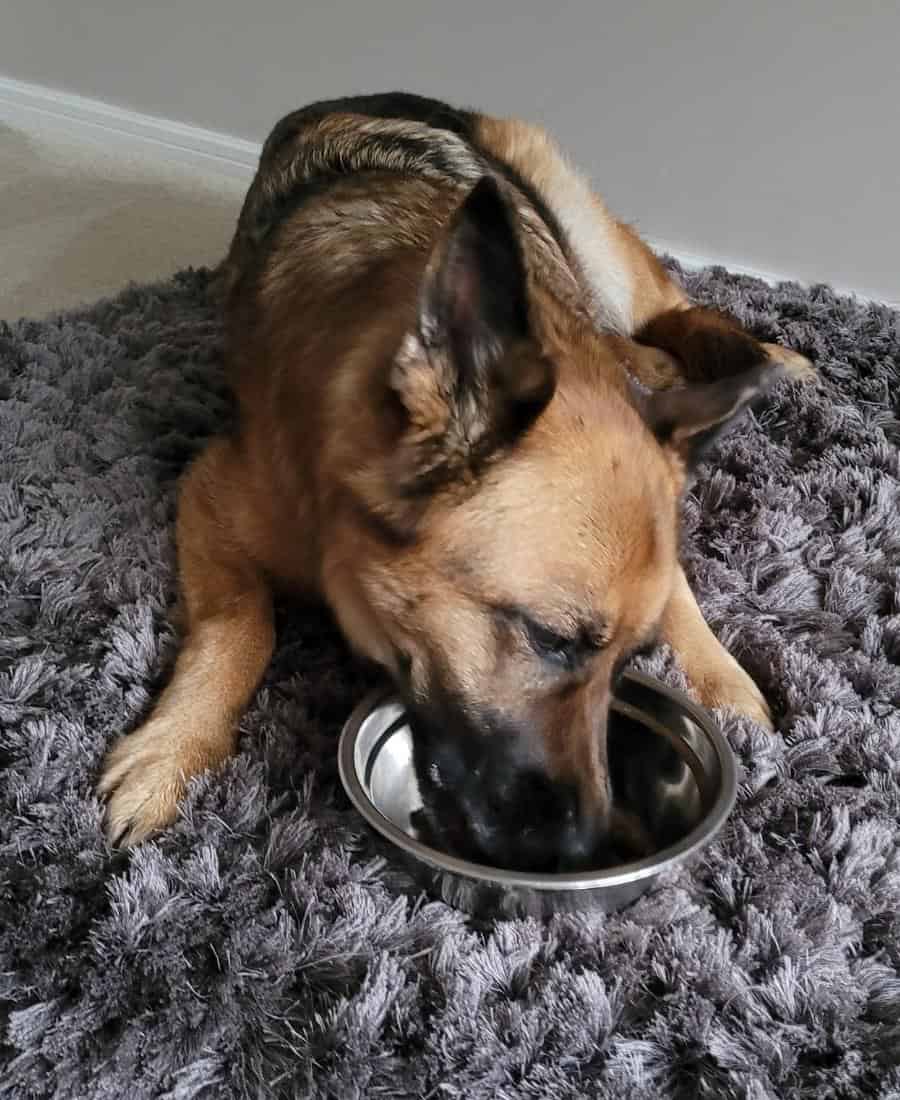
The AAFCO also provides information on understanding dog food labels. It’s a pretty heavy read, but it essentially means that manufacturers will nutritionally label dog food depending on the dog’s life stage.
Here’s a checklist to buy the right dog food:
- Does it contain high-quality protein source?
- Does it contain vitamins and minerals?
- Does it match his lifestyle and size?
- Is it approved by your GSD’s vet?
Many pet food companies have invested millions of dollars into researching what ingredients contain the maximum levels to achieve a healthy, balanced diet that aids in essential puppy growth and mental and physical development.
Let’s now look at the popular types of dog food that should help you decide on the best diet for your German Shepherd.
Dry Foods
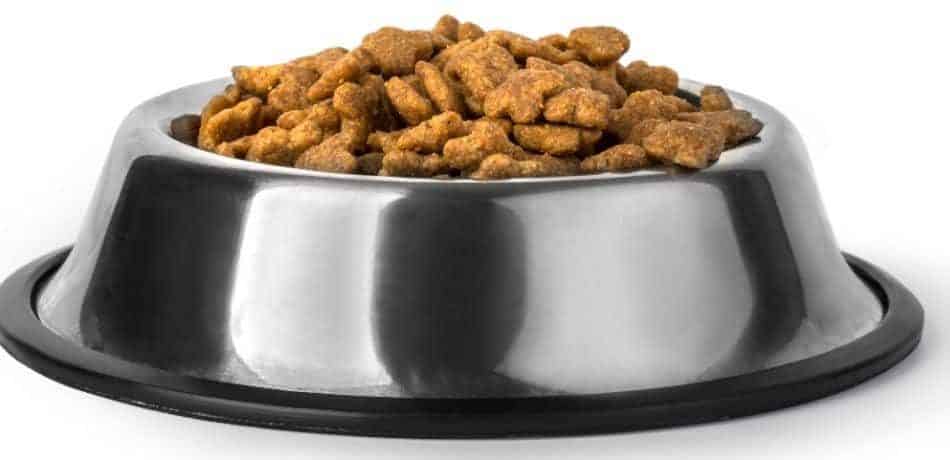
Dry dog foods are one of the most popular choices. Two main types of complete dry foods are KIBBLE and COLD-PRESSED DOG FOOD.
The latter is gaining popularity in the United States and other regions and is widespread in the UK and Europe. Cold-pressed food is deemed a higher quality kibble due to its cooking process.
So what exactly is kibble? Kibble is dry dog food made either through extrusion or oven baking. The food is produced under high pressure and high temperatures. All kibble is made the same way and using the same machinery. Even high-quality dry foods that use “human-grade” ingredients are made using the same process.
What is cold-pressed dog food? Cold-pressed dog food is dry food made at much lower temperatures and cooked quickly before being pressed into the desired shape. This unique method means the food retains more nutritional value, flavor, aroma, and vitamins. All the goodness is retained in bite-size pieces.
The difference?
- Dry dog food provides more nutrients per bite than wet food because they contain less moisture. That means you won’t have to feed as much to satisfy your German Shepherd’s appetite and nutritional needs. You may give dry food completely dry or add water to make it into a tasty “gravy.”
- If you wish to compare dry food with canned wet food, dry costs less per serving, and there can be less waste as it can be left in your dog’s feeding dish longer, unlike canned. Dogs with dental problems may also benefit from dry food as it helps to clean their teeth and gums.
Dry dog food is the most practical choice for a large dog, especially a German Shepherd. However, dry food comes in all shapes and sizes, so a smaller sized variety can be suitable for smaller breeds.
It is also okay to feed your dog a pure dry diet and add cooked meat, fish, or vegetables, and this is what I do. I feed Willow cold-pressed dog food, and although this is a complete, balanced, high-quality food, I like to mix things up for my German Shepherd.
So, as you can see in the below photo, I’ll often add a small amount of cooked lean chicken, beef, pork, salmon, or even a spoonful of plain yogurt.
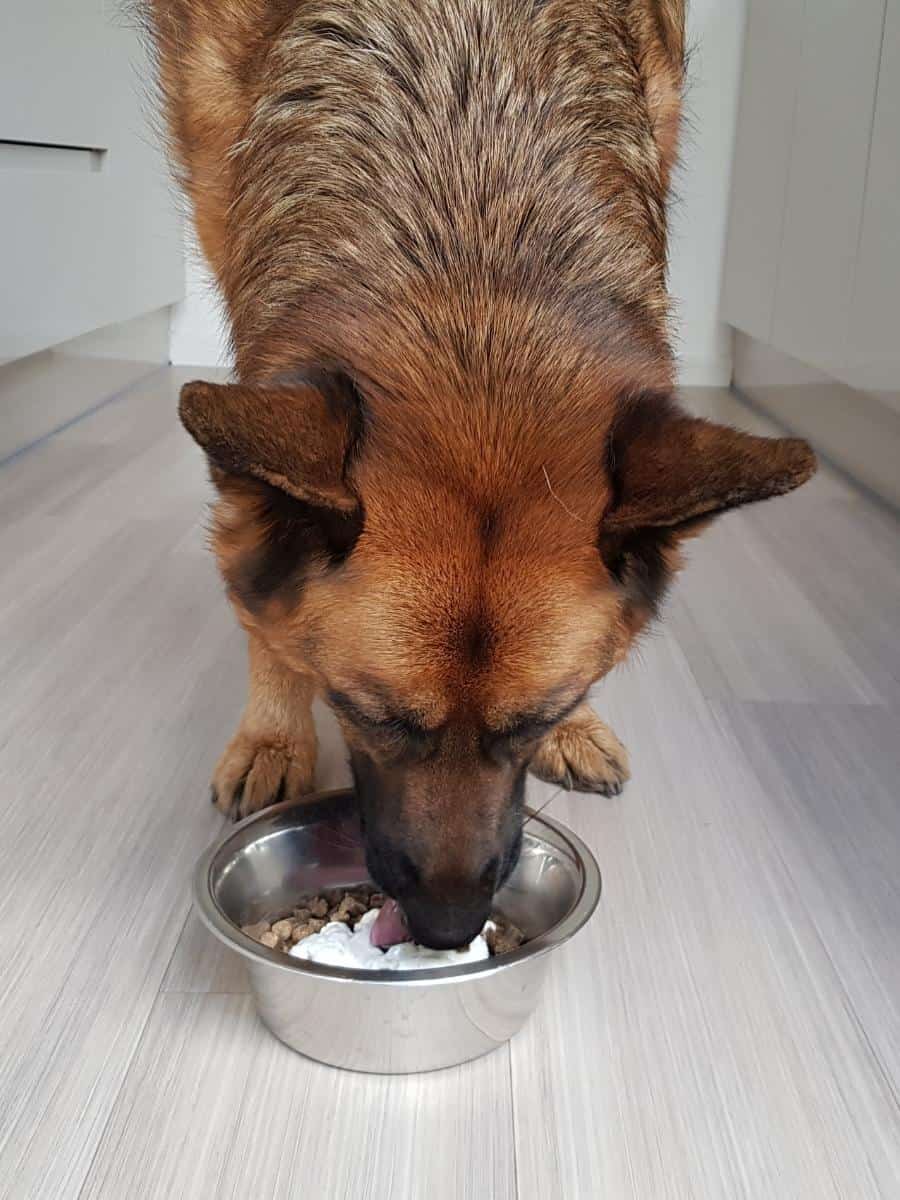
Occasionally my dog will have some tinned tuna or mackerel in oil, which is also excellent for her skin and coat. If I add a topping, I always slightly reduce the quantity of the food to ensure that she is not gaining extra calories.
Canned Wet Foods
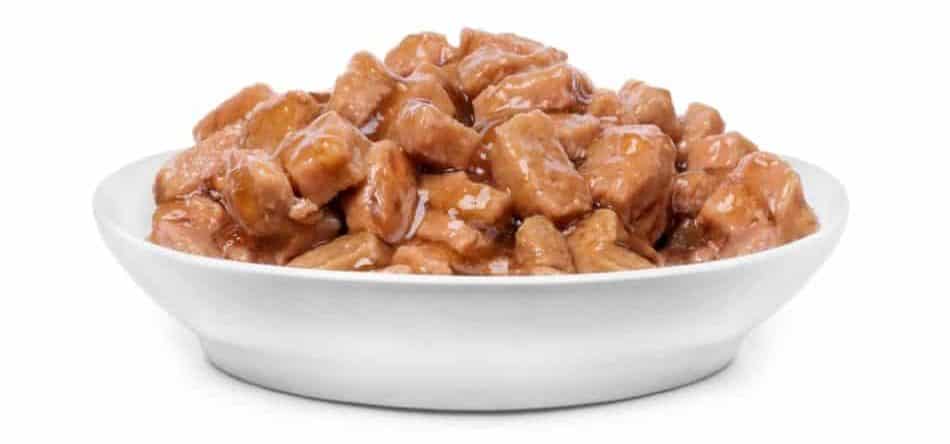
Canned wet dog foods contain high moisture content – around 75%. There are some things to be wary of; not every canned food brand provides the protein your German Shepherd needs.
Also, the higher the water content, the fewer nutrients, so your dog has to consume more food to get the nutritional value their body needs.
Additionally, be wary of low-quality canned foods, as manufacturers often add wheat flour as a thickener or extra white rice or other grains.
“Canned dog food can be more expensive, especially if you have a large dog breed, but it may be ideal if your dog enjoys eating a more considerable portion.”
Other advantages of wet food are that it may be more suitable if your GSD is a fussy eater or if you have a senior dog who may have lost his appetite and find wet food more palatable.
Semi-moist Dog Foods
Semi-moist dog foods are not as popular as other types as they offer the least nutritional value and can be pretty expensive.
Unfortunately, manufacturers add sugar and salts to preserve moisture and shelf life. Therefore, a semi-moist diet may not be appropriate for your German Shepherd, especially if he is overweight and needs to lose a few pounds.
Many semi-moist foods are also loaded with artificial colors, chemical preservatives, and flavor enhancers.
“However, semi-moist food may be the best choice if your German Shepherd finds it challenging to digest all other types of dog food.”
Your dog may also enjoy the meaty taste and find this food more palatable if they are incredibly picky.
Semi-moist dog food is also very convenient because you simply need to open the pouch (usually resealable) and pour it into your dog’s bowl.
If you are considering this type of dog food, seek your vet’s advice to determine the calorie content of the food and an appropriate daily portion for your dog.
Dry Dog Food vs. Wet Dog Food
| Dry Dog Food | Wet Dog Food (including semi-moist) |
|---|---|
| More practicable for large dogs | More practicable for a toy or small breeds |
| Inexpensive and less waste | More expensive than dry foods |
| Provides more nutrients per bite than wet | Good for picky and senior dogs |
| Convenient and easy to feed | Good for hydration if your dog doesn’t drink much |
| No need to refrigerate | There can be more waste if the food is uneaten |
| Good for “grazers” as can be left in the bowl longer | Good for dogs who have trouble chewing |
| Can add cooked meats, fish, or veg for variety | It has a longer shelf life than dry |
| Can add water to make a tasty gravy | Dogs can enjoy a larger portion per meal due to the high water content |
| Available in many shapes and sizes | Some dogs find wet more palatable than dry foods |
| Great for interactive feeders | Watch out for added salt and sugar in semi-moist |
| It can be good for the teeth | May contribute to gum disease |
A Mix of Dry and Wet
A third option is choosing a mix of dry and wet foods. You can mix the foods in the same bowl or feed dry for the morning and wet for the afternoon feed (or vice-versa). Some German Shepherd owners that feed dry dog food like to add wet food as a topping.
Again, you will need to ensure you’re not increasing your dog’s calorie intake if mixing these foods, and you may need to seek the advice of your veterinarian to ensure that you are feeding the correct nutrition. If you choose this option, keeping to the same brand is advisable.
| Pros of a Dry & Wet Mix | Cons of a Dry & Wet Mix |
|---|---|
| You get the best of both dry and wet | Need to track calorie intake |
| Can mix in the same bowl or at separate feeds | May require the advice of a vet |
| Provides variety | Recommended to keep to the same brand |
Home Produced Diet
Some German Shepherd owners feed their dogs a home-produced diet (home-feeders). If you’re wondering exactly why someone would want to be a home feeder, here are the main reasons:
- They sought alternatives to commercial pet foods as they were concerned about the nutritional value of the ingredients and preferred “human foods.”
- They simply enjoyed preparing the food and strengthening the bond with their dog or satisfying their views.
- They believe their pets will not like or refuse commercial dog food.
- They may need a home-prepared diet to help with a diagnosis (e.g., for a food elimination trial).
- They may require a home-prepared diet if a dog has a combination of diseases for which no commercial diet exists.
- They sought comfort as a home-feeder for dogs with chronic or terminal illnesses.
There are several drawbacks to the home preparation of dog food. You can do it, but it takes a lot of dedication and hard work, and it may be more expensive than even the best quality dog food on the market.
“Homemade diets can provide complete nutrition. However, you need to ensure your German Shepherd gets the right mix of protein, fats, carbohydrates, minerals, and vitamins, which is not easy.”
Suppose you wish to prepare a home-cooked diet. In that case, it’s best to consult your vet or a pet nutritionist certified by the American College of Veterinary Nutrition who has the expertise to customize a healthy diet for your pet.
It is recommended to cook all animal products to kill bacteria that could make your German Shepherd sick. However, if you are a raw feeder (see below), you will likely disagree with this statement. Grains, beans, and starchy vegetables must also be cooked to make them easier for your dog to digest.
Never add foods that are toxic to dogs. These include chocolate, grapes, raisins, onions, garlic, avocados, and macadamia nuts, to name but a few.
Do you want to know more about homemade diets? Check out this article, A Beginner’s Guide to Homemade Food for German Shepherds.
My final thoughts on helping you decide on whether to become a home feeder would be:
- Do you have the time to become a home feeder?
- There are plenty of high-quality commercial dog foods on the market.
- Your dog will require regular health checks to check for any nutrient deficiencies.
| Pros of Home Produced Diet | Cons of Home Produced Diet |
|---|---|
| You are in control of your dog’s food and nutrients | Regular health checks are advised to ensure correct nutrition |
| May suit picky eaters | Expensive and time-consuming |
| Can help increase bonding | |
| Can assist with a medical diagnosis or healing |
Raw Diet
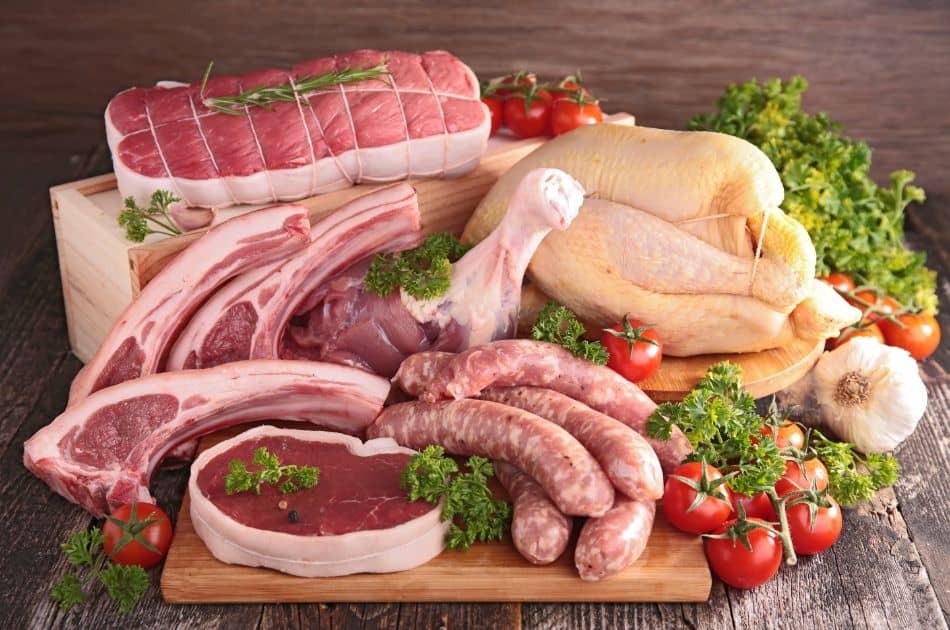
Feeding a German Shepherd puppy raw food can begin at around three to four weeks of age. This approach is based on mimicking the natural diet they would consume in the wild. However, maintain a balanced and nutrient-rich diet to prevent health issues, especially for growing puppies.
When considering a raw diet for your dog, there are two primary concerns. First, ensuring that you provide a complete and balanced diet is vital, which becomes even more critical when dealing with a growing puppy, pregnant or lactating dogs, or those with specific nutritional needs. Consulting a vet or pet nutritionist is strongly recommended.
Secondly, raw food safety is a significant concern, as it can be prone to bacterial or parasitic contamination, posing a risk of food poisoning. To embark on a raw food diet, it’s essential to follow safe handling guidelines and be aware of these potential safety issues.
Proponents of raw diets often highlight numerous potential benefits, such as improved digestion, a healthier coat and skin, stronger teeth, reduced disease risk, and enhanced overall well-being for your German Shepherd.
According to the American College of Veterinary Nutrition, the vast majority of the believed benefits of feeding raw foods remain unproven. Here’s what they say:
“No studies have examined differences in animals fed raw animal products to those fed any other type of diet (kibble, canned, or home-cooked) with the exception of looking at the effects on digestibility.
ACVN
| Pros of Raw Diet | Cons of Raw Diet |
|---|---|
| You control your dog’s food and nutrients | Need to ensure proper nutrition is provided |
| Aids better digestion | May be unsuitable for sick or senior dogs |
| Better stools | Risk of food contamination |
| Cleaner teeth and better breath | No proven health benefits & health checks advised |
Dehydrated and Freeze-Dried
You can feed your German Shepherd a dehydrated or freeze-dried diet, which has become increasingly common in recent years.
These diets are similar in that they extract moisture from the food to preserve it and eliminate the need for artificial preservatives, but they vary in several ways.
Dehydrated Foods
Dehydrated foods are partially cooked at low temperatures to extract most of the water. The food is heated but not fully cooked, so nutrients and enzymes remain whole. They are a complete diet frequently seen as a step up from ordinary extruded kibble.
You must add warm water to dehydrated dog food to make it edible. As a result, the food has a texture comparable to canned wet food but is much less refined.
These foods are easy to store, and prepare, and have a long shelf life because they do not need refrigeration.
“A dehydrated diet is also a good option if your German Shepherd has a sensitive stomach, as the food is easier on the digestive system due to the gentle cooking method.”
Freeze-dried
Freeze-dried foods are essentially a raw diet that has been repackaged.
The raw ingredients in freeze-dried dog food are frozen first, and then placed in a strong vacuum to turn the moisture into vapor. After that, the food is sealed in an airtight container. Unlike a proper raw diet, this method reduces the number of bacteria such as salmonella.
Although freeze-dried food looks like kibble and does not need to be rehydrated before eating, your German Shepherd will find it more palatable and digestible if you add water first.
Freeze-dried foods are usually very high protein diets with fruits and vegetables occasionally added. This dog diet is an excellent alternative if you want to feed a raw diet but don’t like to handle raw food but want to provide a healthier and less processed diet.
You can also combine freeze-dried into your German Shepherds’ diet with other types such as kibble or wet.
“Freeze-dried foods are more expensive than regular kibble, but as the food has the moisture removed, they are more nutritionally dense, so you feed your GSD less.”
| Pros of Dehydrated & Freeze-Dried | Cons of Dehydrated & Freeze-Dried |
|---|---|
| Nutrients remain intact | Very expensive |
| No added preservatives | Freeze-dried foods may still contain bacteria |
| Convenient | Freeze-dried products might be hard to source |
| Long shelf life and easy to store |
How Much Food Should a German Shepherd Eat?
The amount of food your German Shepherd needs will largely depend on your pet’s size, activity level, age, and overall health. The key is to ensure you don’t overfeed or underfeed your dog. So, how much food should a German Shepherd eat?
An active adult German Shepherd weighing 70lbs (32kg) needs 1740 calories daily, whereas an active, larger-sized German Shepherd weighing 90lbs (40kg) needs 2100 calories daily. In contrast, inactive GSDs of similar weights only need 1272 calories and 1540 calories, respectively.
You also need to assess your dog’s activity level. German Shepherds who get minimal exercise may need 10% less than what’s recommended on the food label, whereas an active dog that regularly exercises may need 20% to 40% more.
“Working German Shepherds, such as police dogs, may need foods designed for working or performance dogs. These foods have a higher fat content to provide extra calories for their needs.”
Additionally, you may need to make adjustments based on your dog’s health or body condition. Serious illness, pregnancy, or nursing can also increase a dog’s energy needs.
All commercial dog food will have recommended feeding guidelines on the packaging. I also found this helpful dog calorie calculator you can use.
Pro Tip! Although dogs can eat just once daily, most GSD owners prefer feeding twice daily. Giving two meals daily makes it easier for the dog to digest the food, which helps control hunger and bloat (GDV), a life-threatening condition. I feed my German Shepherd twice a day.
How Much Food Should a German Shepherd Puppy Eat?

So, what about puppies, you may ask? How much should you feed a German Shepherd puppy?
A German Shepherd puppy needs about twice as many calories per pound of body weight as an adult German Shepherd. Therefore, a mature puppy weighing 45lbs (20kg) needs around 2100 calories, the same as an active adult twice its weight.
Here’s a rough guide on how much dry food to feed your German Shepherd puppy.
| Weight of Puppy | Age of Puppy | Dry Food In Grams |
|---|---|---|
| 8-10lbs | 2-3 months | 150-175 |
| 20lbs | 2-3 months | 300 |
| 40lbs | 2-3 months | 495 |
| 60lbs | 2-3 months | 695 |
| 20lbs | 4-9 months | 250 |
| 40lbs | 4-9 months | 420 |
| 60lbs | 4-9 months | 570 |
| 80lbs | 4-9 months | 695 |
| 100lbs | 4-9 months | 845 |
| 40lbs | 10-12 months | 330 |
| 60lbs | 10-12 months | 465 |
| 80-100lbs | 10-12 months | 560-670 |
| 120-140lbs | 10-12 months | 770-860 |
| 160-180lbs | 10-12 months | 945-1040 |
Pro Tip! When my German Shepherd was a growing puppy, I visited my vet monthly to weigh her and get a quick overall check of her general health.
German Shepherd Feeding Schedule & Meal Plan
Puppies receive all the relevant nutrients from birth by feeding on their mother. However, it’s safe to begin the weaning process onto a new diet for your German Shepherd after three to four weeks.
As mentioned, a growing German Shepherd puppy has different nutritional needs than an adult dog. But did you know puppies also need feeding more frequently at various stages of growth?
You should feed a German Shepherd puppy four meals daily between 6 and 12 weeks old. Puppies aged between 12 and 24 weeks require three meals a day, and from 24 weeks onwards, German Shepherd puppies should be fed twice daily.
| AGE OF PUPPY | DAILY MEALS |
| 6 to 12 weeks | 4 |
| 12 to 24 weeks | 3 |
| 24 weeks onwards | 2 |
Can German Shepherds Eat Bones?
Do you remember the saying, “give a dog a bone?” But can German Shepherds eat bones as part of their diet?
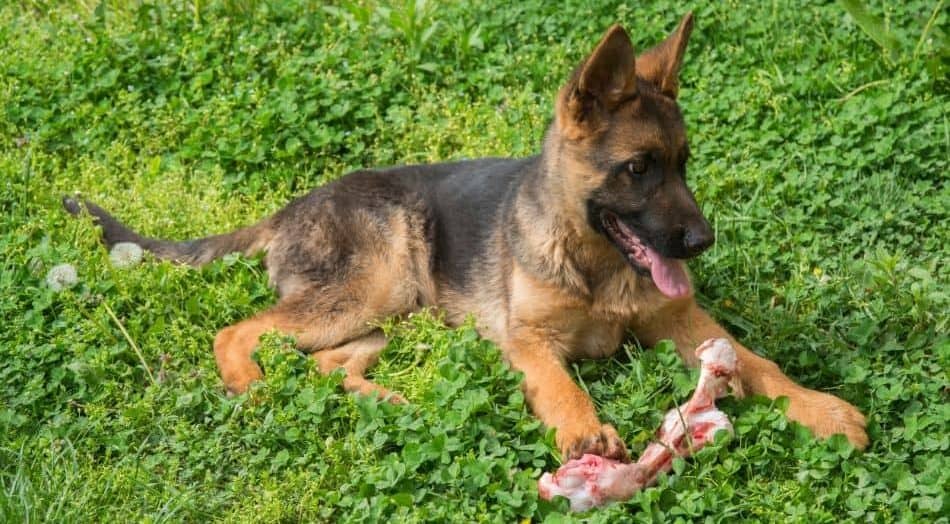
German Shepherds can eat bones. They are a good source of nutrients, especially calcium and phosphorus, and help clean your dog’s teeth and keep them strong. However, never feed a cooked bone as cooking causes the bone to soften and splinter as your dog chews it and can cause injuries or choking.
- Choose a sizeable raw bone larger than your dog’s muzzle so he won’t be tempted to swallow it.
- Beef or lamb bones are better than chicken or pork bones as they are stronger and won’t easily splinter. For example, a large beef shank bone would be just the thing for your German Shepherd.
- Remember to supervise your GSD when giving him a bone.
Best Treats for German Shepherds
Many owners give treats and snacks as part of their German Shepherd’s diet, but they should not exceed 10% of your dog’s total daily calories. Also, dog treats don’t have to follow AAFCO standards, so many may provide little nutritional value.
But this isn’t true of all dog treats on the market.
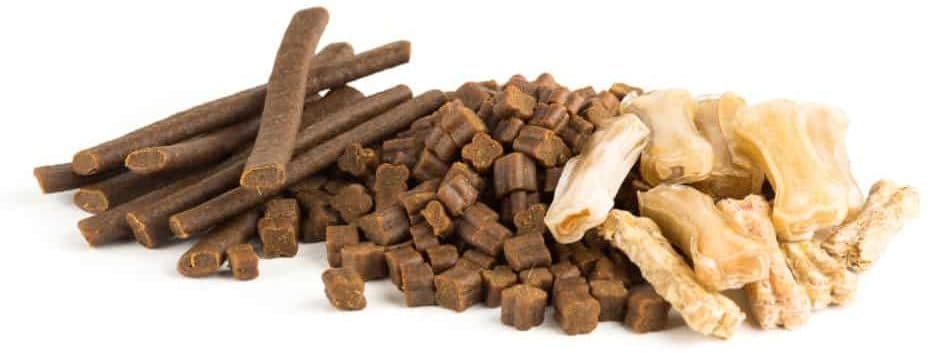
The best treats for German Shepherds are carefully formulated for dogs and contain high-quality, nutritious ingredients. They should be low in fat and calories and free of additives, chemicals, and coloring.
There are some excellent high-quality treats you can buy. However, some can be pretty expensive, so shop around.
However, I’m happy to pay that bit more if it means my GSD stays healthy and happy. Willow loves her Dentastix treats, as shown in the photo below.
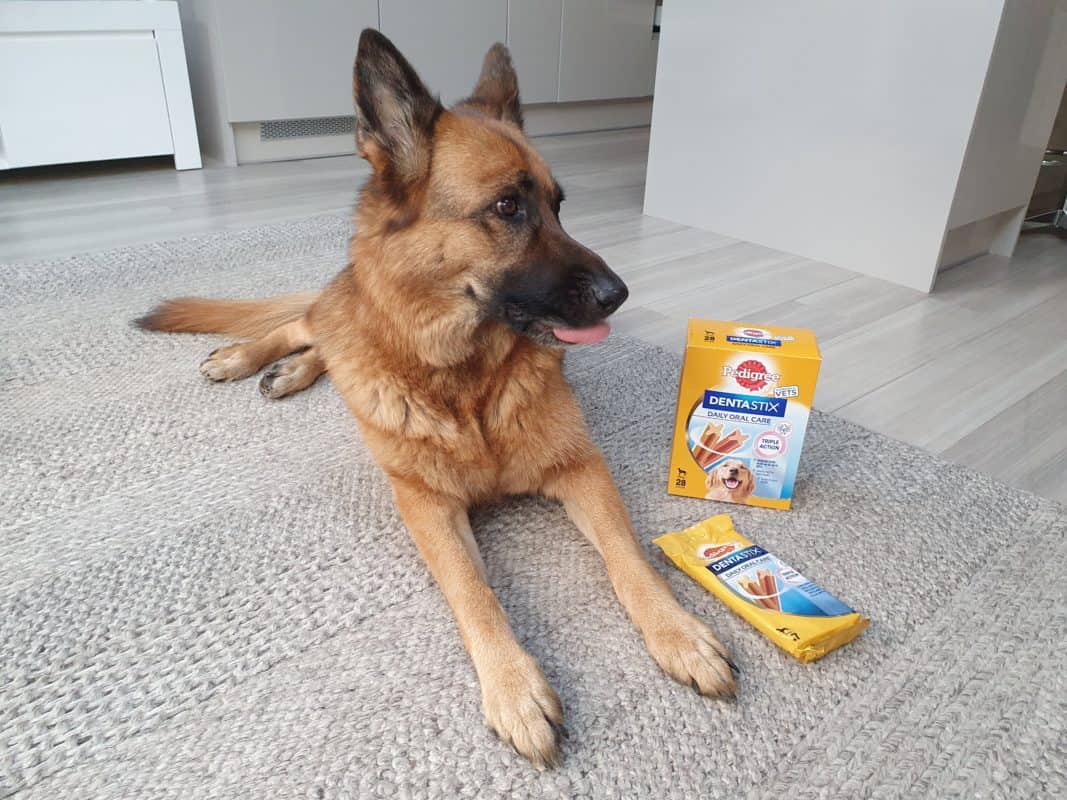
FAQs
Do German Shepherds Need Vitamins or Supplements?
German Shepherds don’t need to add vitamins or supplements to their diet if they eat good quality, complete, balanced pet food and are healthy. You should only give your dog vitamins or supplements if your veterinarian recommends them.
For example, my German Shepherd was recently diagnosed with osteoarthritis of the spine. In addition to her prescribed medication, her vet recommended she take YuMove Joint Supplements from Amazon, which contain glucosamine and chondroitin for joint support and to ease stiffness.
I have to say I’ve been pleased with how she is doing on them, so if your dog has a similar condition, I’d advise you to consult your vet.
How Much Water Should a German Shepherd Drink?
Adult German Shepherds should drink one ounce (30 ml) of water daily for each pound they weigh. Puppies will generally consume more, despite their smaller size. Some variables include age, size, activity level, type of food eaten (dry or wet), weather, medication, or lactation.
Ensure you keep your dog’s water bowl filled up and frequently change it throughout the day. If your dog is not drinking enough water, here are some fun ways to keep him hydrated:
- Give your dog ice cubes.
- Make doggie ice pops.
- Add water to dry food.
- Make fun playtime with a hose in the summer.
Final Thoughts – The Importance of Nutrition
So, there you have it – the best food for German Shepherds with a crisp meal plan and key dietary components. There’s certainly a lot to consider in this giant guide, but I hope I’ve given you enough food for thought!
When choosing what to feed your German Shepherd, the best advice I could give you is:
- Choose a meal plan that suits your dog’s life stage and your lifestyle.
- Invest in the best quality dog food you can afford.


